Barkhausen Noise Emission as a Function of Tensile Stress in Low-Alloyed Steels: Influence of Corrosion and Steel Strength
Abstract
1. Introduction
2. Experimental Conditions
- -
- MBN, which refers to the effective value of the signal;
- -
- PP (Peak Position), which is linked to the position of the maximum of the MBN envelope;
- -
- FWHM (full-width at half-maximum) of the MBN envelope.
3. Results of Experiments and Discussion
3.1. Wall Thickness
3.2. MBN Measurements
- -
- The corroded layer on the surface makes a weaker magnetic field in the un-corroded matrix;
- -
- The corroded layer attenuates electromagnetic pulses propagating toward the free surface;
- -
- Increasing the height of surface irregularities also makes the transfer of electromagnetic pulses toward the sensing coil more difficult [31];
- -
4. Conclusions
- -
- Higher MBN values are linked with lower thicknesses of a corroded layer;
- -
- Higher MBN values are linked with higher tensile stresses in RD and a lower MBN in TD;
- -
- PP values in RD are higher for heavily corroded samples, but the sensitivity against stress is limited;
- -
- FWHM values in RD are higher for heavily corroded samples, but the sensitivity against stress for MC700 and MC1100 is also limited;
- -
- FWHM for S235 drops down with tensile stress in RD;
- -
- PP and FWHM in TD exhibit a lack of sensitivity against corrosion attack as well as tensile stress.
Author Contributions
Funding
Institutional Review Board Statement
Informed Consent Statement
Data Availability Statement
Conflicts of Interest
References
- De Ardo, A.J.; Hua, M.J.; Cho, K.G.; Garcia, G.I. On strength of micro alloyed steels: An interpretive review. Mater. Sci. Technol. 2009, 25, 1074. [Google Scholar] [CrossRef]
- Zhang, H.K.; Xiao, H.; Fang, X.W.; Zhang, Q.; Logé, R.E.; Huang, K. A critical assessment of experimental investigation of dynamic recrystallization of metallic materials. Mater. Des. 2020, 193, 108873. [Google Scholar] [CrossRef]
- Zhao, M.; Huang, L.; Li, C.; Li, J.; Li, P. Evaluation of the deformation behaviors and hot workability of a high-strength low-alloy steel. Mater. Sci. Eng. A 2021, 810, 141031. [Google Scholar] [CrossRef]
- Vervynckt, S.; Verbeken, K.; Lopez, B.; Jonas, J.J. Modern HSLA steels and role of non-recrystallisation temperature. Int. Mater. Rev. 2012, 57, 187208. [Google Scholar] [CrossRef]
- Xu, J.; Sun, H.; Cai, S. Effect of symmetrical broken wires damage on mechanical characteristics of stay cable. J. Sound Vib. 2019, 461, 114920. [Google Scholar] [CrossRef]
- Anania, L.; Badala, A.; D’Agata, G. Damage and collapse mode of existing post tensioned precast concrete bridge: The case of Petrulla viaduct. Eng. Struct. 2018, 162, 226–244. [Google Scholar] [CrossRef]
- Li, S.; Hu, P.; Zhao, X.; Chen, K.; Li, J. Atmospheric corrosion performance of wire rope sling in sulphur dioxide-polluted environment. Adv. Mech. Eng. 2017, 9, 1687814017707479. [Google Scholar] [CrossRef]
- Antunes, R.A.; Ichikawa, R.U.; Martinez, L.G.; Costa, I. Characterization of corrosion products on carbon steel exposed to natural weathering and to accelerated corrosion tests. Int. J. Corros. 2014, 2014, 419570. [Google Scholar] [CrossRef]
- Li, D.; Yang, W.; Zhang, W. Cluster analysis of stress corrosion mechanism for steel wires used in bridge cables through acoustic emission particle swarm optimization. Ultrasonics 2017, 77, 22–31. [Google Scholar] [CrossRef]
- Martin, J.; Broughton, K.J.; Giannopolous, A. Ultrasonic tomography of grouted duct post-tensioned reinforced concrete bridge beams. NDT E Int. 2001, 34, 107–113. [Google Scholar] [CrossRef]
- Peng, P.; Wang, C. Use of gamma rays in the inspection of steel wire ropes in suspension bridges. NDT E Int. 2015, 75, 80–86. [Google Scholar] [CrossRef]
- Cao, Y.N.; Zhang, D.L.; Xu, D.G. The state-of-Art of quantitative testing of wire rope. Nondestruct. Test. 2005, 27, 91–95. [Google Scholar]
- Christen, R.; Bergamini, A.; Motavalli, M. Influence of steel wrapping on magnetic-inductive testing of the main cable of suspension bridges. NDT E Int. 2009, 42, 22–27. [Google Scholar] [CrossRef]
- Neslušan, M.; Bahleda, F.; Minárik, P.; Zgútová, K.; Jambor, M. Non-destructive monitoring of corrosion extent in steel rope wires via Barkhausen noise emission. J. Magn. Magn. Mater. 2019, 484, 179–187. [Google Scholar] [CrossRef]
- Jančula, M.; Neslušan, M.; Pastorek, F.; Pitoňák, M.; Pata, V.; Minárik, P.; Gocál, J. Monitoring of corrosion extent in steel S460MC by the use of magnetic Barkhausen noise emission. J. Nondestruct. Eval. 2021, 40, 69. [Google Scholar] [CrossRef]
- Pastorek, F.; Decký, M.; Neslušan, M.; Pitoňák, M. Usage of Barkhausen noise for assessment of corrosion damage on different low alloyed steels. Appl. Sci. 2021, 11, 10646. [Google Scholar] [CrossRef]
- Jiles, D. Introduction to Magnetism and Magnetic Materials, 3rd ed.; Taylor & Francis Group: New York, NY, USA, 2016. [Google Scholar]
- Chikazumi, S. Physics of Ferromagnetism, 2nd ed.; Oxford University Press: Oxford, UK, 2005. [Google Scholar]
- Cullity, B.D.; Graham, C.D. Introduction to the Magnetic Materials, 2nd ed.; IEEE Press: Piscataway, NJ, USA, 2009. [Google Scholar]
- Gatelier-Rothea, C.; Chicois, J.; Fougeres, R.; Fleischmann, P. Characterization of pure iron and (130 p.p.m.) carbon-iron binary alloy by Barkhausen noise measurements: Study of the influence of stress and microstructure. Acta Metal. 1998, 46, 4873–4882. [Google Scholar] [CrossRef]
- Neslušan, M.; Čížek, J.; Kolařík, K.; Minárik, P.; Čilliková, M.; Melikhová, O. Monitoring of grinding burn via Barkhausen noise emission in case-hardened steel in large-bearing production. J. Mater. Process. Technol. 2017, 240, 104–117. [Google Scholar] [CrossRef]
- Stupakov, A.; Perevertov, O.; Tomáš, I.; Skrbek, B. Evaluation of surface decarburization depth by magnetic Barkhausen noise technique. J. Magn. Magn. Mater. 2011, 323, 1692–1697. [Google Scholar] [CrossRef]
- Ktena, A.; Hristoforou, E.; Gerhardt, G.J.L.; Missell, F.P.; Landgraf, F.J.G.; Rodrigues, D.L.; Albertis-Campos, M. Barkhausen noise as a microstructure characterization tool. Phys. B Condensed Matter 2014, 435, 109–112. [Google Scholar] [CrossRef]
- Liu, J.; Tian, G.Y.; Gao, B.; Zeng, K.; Zheng, Y.; Chen, J. Micro-macro characteristics between domain wall motion and magnetic Barkhausen noise under tensile stress. J. Magn. Magn. Mater. 2020, 493, 165719. [Google Scholar] [CrossRef]
- Kypris, O.; Nlebedim, I.C.; Jiles, D.C. Measuring stress variation with depth using Barkhausen signals. J. Magn. Magn. Mater. 2016, 407, 377–395. [Google Scholar] [CrossRef]
- Sorsa, A.; Santa-Aho, S.; Wartiainen, J.; Souminen, L.; Vippola, M.; Leviskä, K. Effect of shot peening parameters to residual stress profiles and Barkhausen noise. J. Non-Destruct. Eval. 2018, 37, 10. [Google Scholar] [CrossRef]
- Neslušan, M.; Minárik, P.; Čilliková, M.; Kolařík, K.; Rubešová, K. Barkhausen noise emission in tool steel X210Cr12 after semi-solid processing. Mater. Charact. 2019, 157, 109891. [Google Scholar] [CrossRef]
- Piotrowski, L.; Augustyniak, B.; Chmielewski, M.; Hristoforou, E.V.; Kosmas, K. Evaluation of Barkhausen noise and magnetoacoustic emission signals properties for plastically deformed Armco iron. IEEE Trans. Mag. 2010, 46, 239–242. [Google Scholar] [CrossRef]
- Šrámek, J.; Neslušan, M.; Bahleda, F.; Zgútová, K.; Schenk, P. Influence of sample size and magnetizing voltage on Barkhausen noise during bending and uniaxial tensile test. Acta Phys. Polonica A 2020, 137, 640–643. [Google Scholar] [CrossRef]
- Zgútová, K.; Pitoňák, M. Attenuation of Barkhausen Noise Emission due to Variable Coating Thickness. Coatings 2021, 11, 263. [Google Scholar] [CrossRef]
- Deng, Y.; Li, Z.; Chen, J.; Qi, X. The effect of the structure characteristics on Magnetic Barkhausen noise in commercial steels. J. Magn. Magn. Mater. 2018, 451, 276–282. [Google Scholar] [CrossRef]
- Sakamoto, H.; Okada, M.; Homma, M. Theoretical analysis of Barkhausen noise in carbon steels. IEEE Trans. Magn. 1987, 23, 2236–2238. [Google Scholar] [CrossRef]
- Stupakov, A.; Perevertov, A.; Neslušan, M. Reading depth of the magnetic Barkhausen noise. I. One-phase semi-hard ribbons. J. Magn. Magn. Mater. 2020, 513, 167086. [Google Scholar] [CrossRef]
- Stupakov, A.; Perevertov, A.; Neslušan, M. Reading depth of the magnetic Barkhausen noise. II. Two-phase surface-treated steels. J. Magn. Magn. Mater. 2020, 513, 167239. [Google Scholar] [CrossRef]
- Neslušan, M.; Pitoňák, M.; Minárik, P.; Tkáč, M.; Kollár, P.; Životský, O. Influence of domain walls thickness, density and alignment on Barkhausen noise emission in low alloyed steels. Sci. Rep. 2023, 13, 5687. [Google Scholar] [CrossRef] [PubMed]
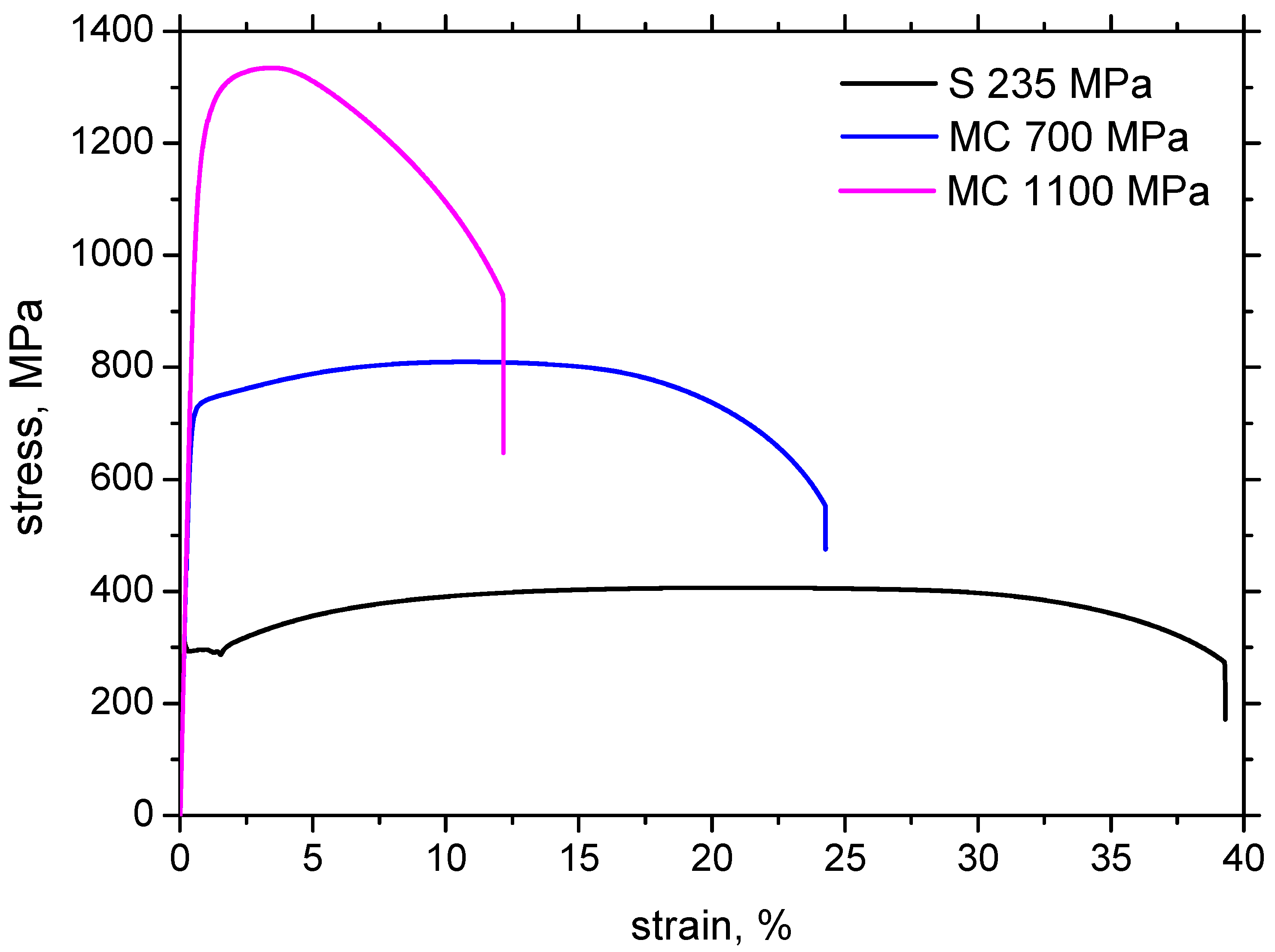

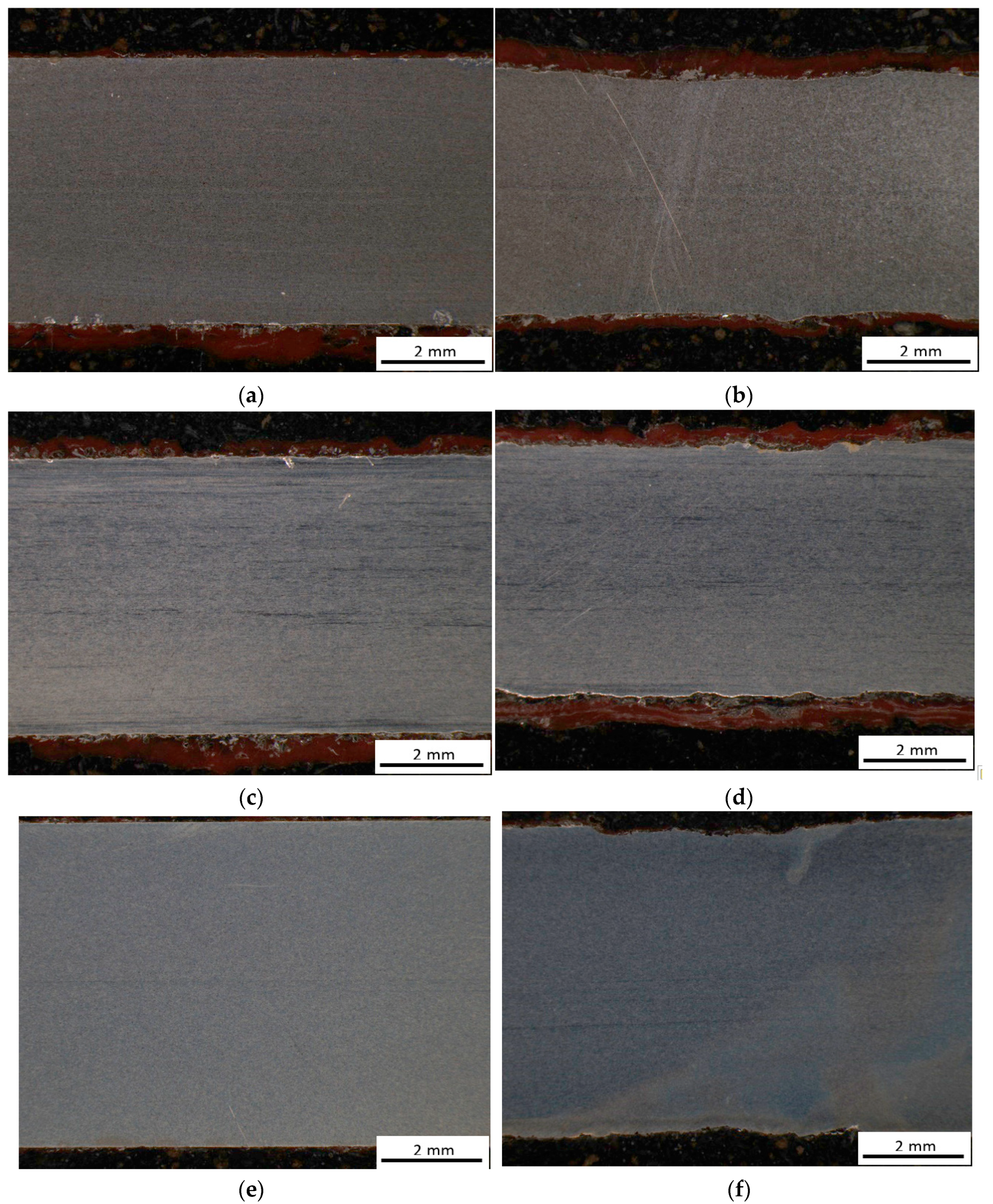
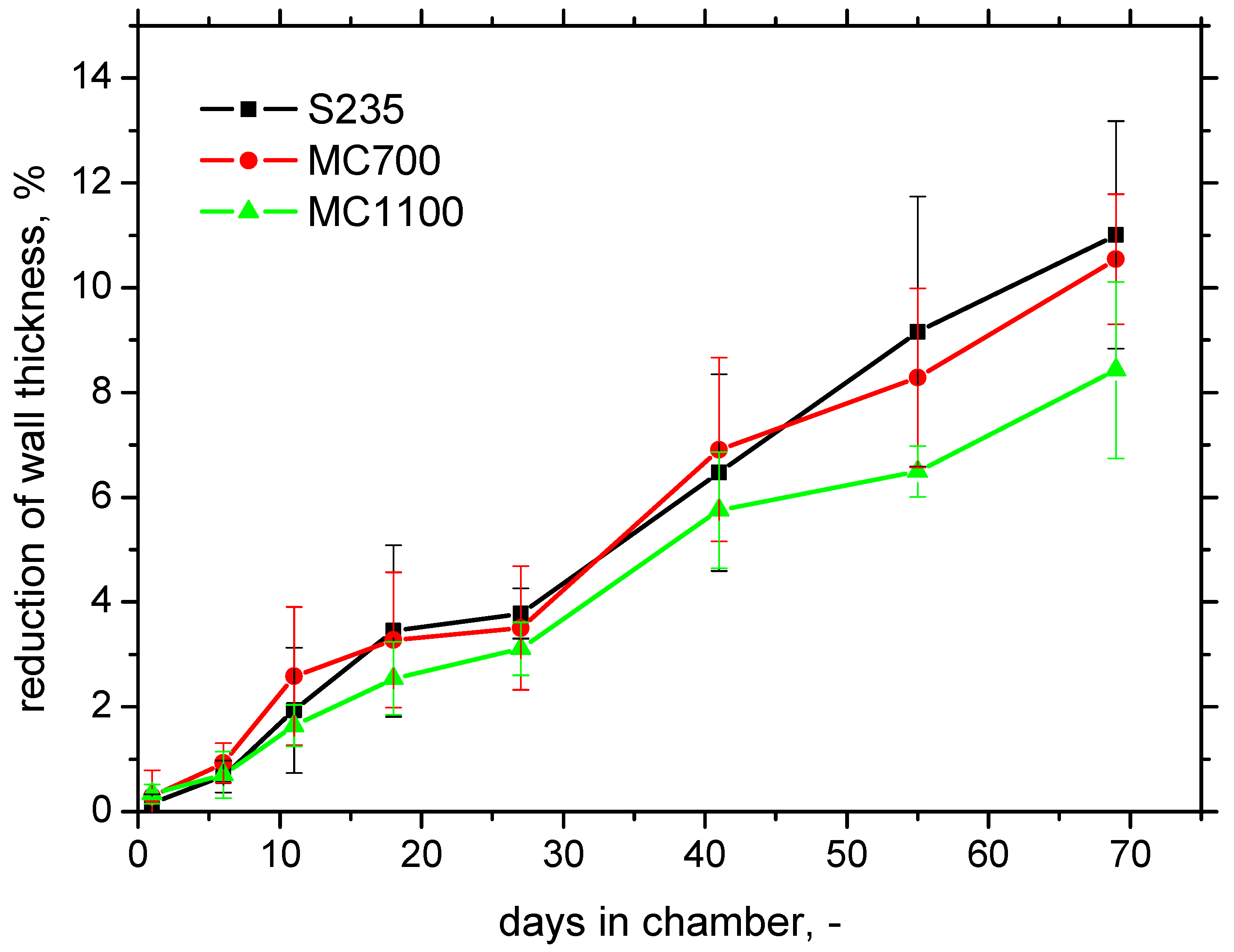



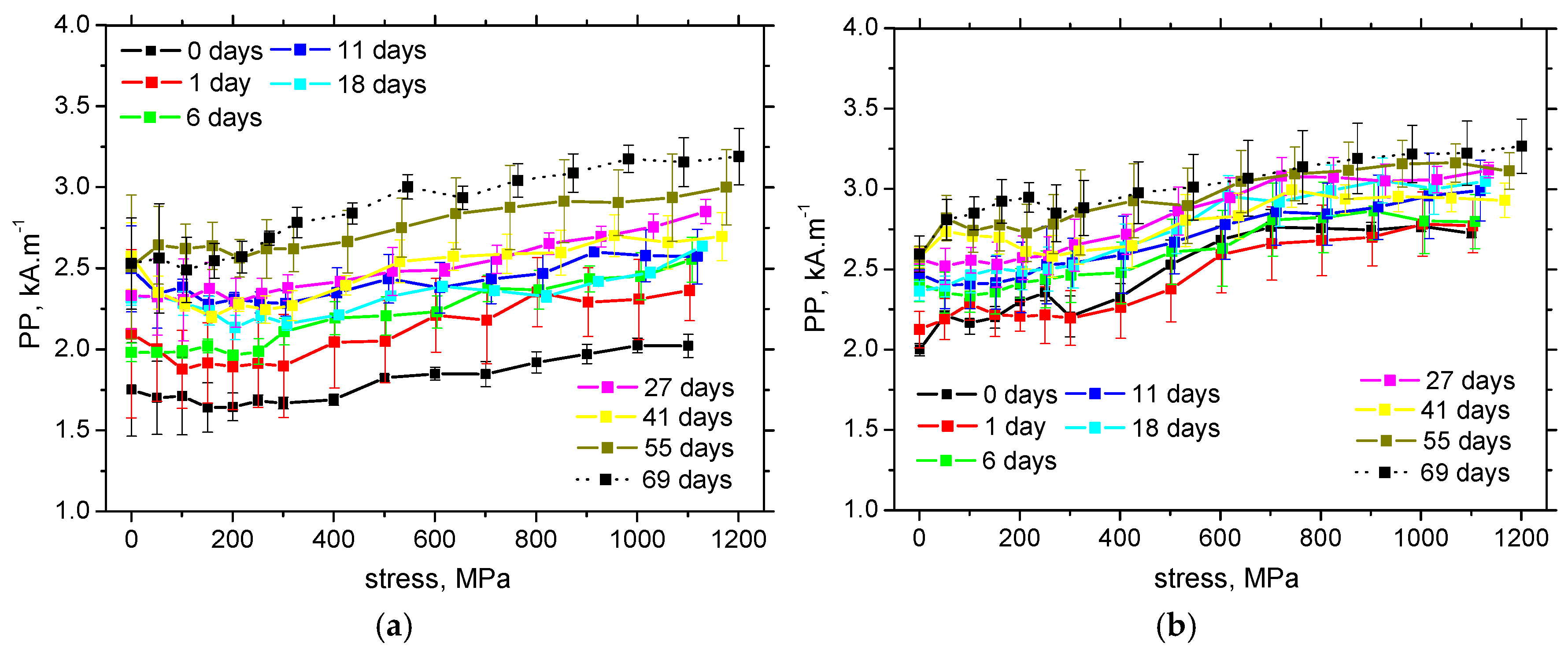
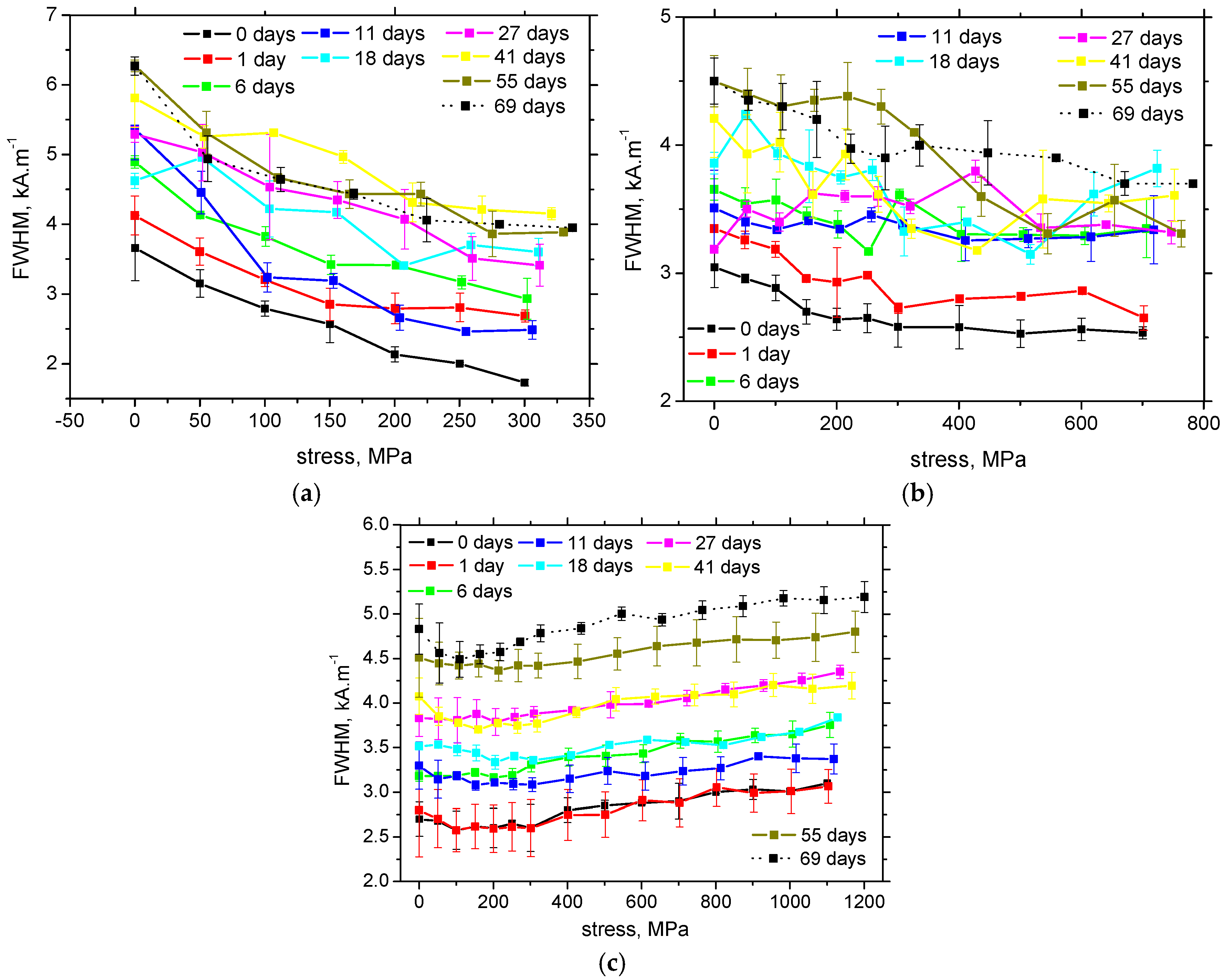
| Sample Number | 1 | 2 | 3 | 4 | 5 | 6 | 7 | 8 |
| Number of days | 1 | 6 | 11 | 18 | 27 | 41 | 55 | 69 |
| MBN—Effective Value | PP | FWHM | ||||
|---|---|---|---|---|---|---|
| RD | TD | RD | TD | RD | TD | |
| corrosion | ↓ | ↓ | ↑ | ↑ | ↑ | ↑ |
| Tensile stress | ↑ | ↓ | ↑ | ↑ | ↓ * | ↓ * |
Disclaimer/Publisher’s Note: The statements, opinions and data contained in all publications are solely those of the individual author(s) and contributor(s) and not of MDPI and/or the editor(s). MDPI and/or the editor(s) disclaim responsibility for any injury to people or property resulting from any ideas, methods, instructions or products referred to in the content. |
© 2023 by the authors. Licensee MDPI, Basel, Switzerland. This article is an open access article distributed under the terms and conditions of the Creative Commons Attribution (CC BY) license (https://creativecommons.org/licenses/by/4.0/).
Share and Cite
Bahleda, F.; Neslušan, M.; Pastorek, F.; Koňár, R.; Kubjatko, T. Barkhausen Noise Emission as a Function of Tensile Stress in Low-Alloyed Steels: Influence of Corrosion and Steel Strength. Appl. Sci. 2023, 13, 6574. https://doi.org/10.3390/app13116574
Bahleda F, Neslušan M, Pastorek F, Koňár R, Kubjatko T. Barkhausen Noise Emission as a Function of Tensile Stress in Low-Alloyed Steels: Influence of Corrosion and Steel Strength. Applied Sciences. 2023; 13(11):6574. https://doi.org/10.3390/app13116574
Chicago/Turabian StyleBahleda, František, Miroslav Neslušan, Filip Pastorek, Radoslav Koňár, and Tibor Kubjatko. 2023. "Barkhausen Noise Emission as a Function of Tensile Stress in Low-Alloyed Steels: Influence of Corrosion and Steel Strength" Applied Sciences 13, no. 11: 6574. https://doi.org/10.3390/app13116574
APA StyleBahleda, F., Neslušan, M., Pastorek, F., Koňár, R., & Kubjatko, T. (2023). Barkhausen Noise Emission as a Function of Tensile Stress in Low-Alloyed Steels: Influence of Corrosion and Steel Strength. Applied Sciences, 13(11), 6574. https://doi.org/10.3390/app13116574







